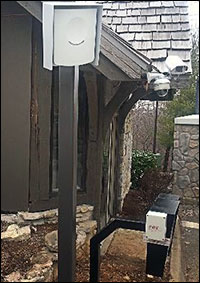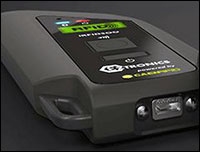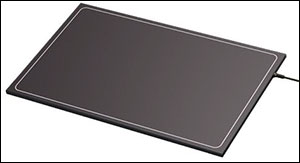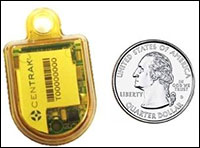The following are news announcements made during the past week by the following organizations:
Dolphin RFID;
Nedap;
CAEN RFID;
RR Donnelley;
IDTronic;
CenTrak.
Dolphin RFID Introduces Real-Time Emergency Mustering System
Dolphin RFID, an India-based developer of radio frequency identification and security solutions, has launched its real-time Dolphin Emergency Mustering System (DEMS). The solution employs Near Field Communication (NFC) RFID technology and is designed to operate even when access-control servers used for monitoring employees’ whereabouts are likely offline.
Most organizations currently have automated access-control systems in place, and these can be linked to Dolphin’s Edgewizard RFID middleware to provide real-time information regarding the entry and exit of personnel. But during an emergency, those systems may not be accessible. The real-time DEMS solution can work independently, in standalone mode, if an access-control system is unavailable. Personnel can be accounted for by simply punching in or out at access points, using RFID readers linked to the Edgewizard RFID middleware.
DEMS also creates automated and real-time synchronized lists and delivers them to smartphones, enabling emergency wardens to track personnel at all times. The system eliminates the manual listing typically carried out for emergency evacuation mustering that generally consists of a record of all employees. Such manual lists seldom account for personnel who have left early or are out on holiday on a given day, which can result in inaccurate lists. Because of this, reconciliation can become very chaotic and time-consuming during an emergency.
The DEMS solution requires the use of NFC-enabled smartphones, which link to the Edgewizard RFID middleware server via a Wi-Fi or GPRS connection. During an emergency, at the mustering station, a warden can account for workers by using his or her smartphone to read their NFC-enabled ID cards, and that data is shared with DEMS, which correlates the information with each employee’s status, according to Dolphin. When a tag is read, the employee’s presence is confirmed and that individual’s name on the list turns green. The warden’s emergency audit list, contained on his or her smartphone, is updated every 10 to 30 seconds. Very quickly, Dolphin RFID explains, the warden thus knows who is missing and can initiate a search-and-rescue plan, if necessary. All details regarding missing personnel can be accessed on the smartphone, and the missing employees’ mobile phones can be immediately called.
“DEMS will revolutionize the Emergency Mustering procedure,” said Commodore S K Sawhney, Dolphin RFID’s president and CEO, in a prepared statement. “Not only does the new system provide users with an enhanced degree of safety in the workplace, it does it at a very affordable cost, without the need for an additional monitoring system. With DEMS, the time wasted on manual reconciliation of lists is saved, which could be the difference between life and death of personnel in danger.”
Dolphin RFID will demonstrate its Dolphin Emergency Mustering System (DEMS) solution in booth 544A at next week’s RFID Journal LIVE! conference and exhibition, taking place in San Diego, Calif.
Ozarks Community Selects Nedap UHF System for Vehicle Access Control
Nedap has announced that Stonebridge, a gated resort community of more than 350 residents in the Ozark Mountains in southwestern Missouri, has selected its uPASS Reach ultrahigh-frequency (UHF) RFID gate-entry solution to provide vehicle access security and convenience.
The Stonebridge Homeowner Association (HOA) had determined that vehicle access to Stonebridge required a higher level of security, protection and user convenience than its existing access-control system provided. That system was causing delays during peak hours, and was inconvenient to use since each driver had to stop at the gate and present credentials to open it. The HOA required a solution that would improve throughput, Nedap explains, without sacrificing the gated community’s security. Furthermore, the company reports, it was important that the solution would not heavily impact the monthly HOA fee for residents.
The uPASS Reach reader offers vehicle identification up to a distance of 5 meters (16 feet), and complies with the ISO 18000-6C and EPC Gen 2 RFID standards. Built-in high-intensity red, green and blue LEDs provide a user with visual feedback that the tag has been read or authorized. The LED and beeper functionality can be controlled via the access-control panel, but can also be preconfigured. According to Nedap, the uPASS Reach reader features an integrated, fine-tuned antenna in a compact enclosure, measuring 200 millimeters by 220 millimeters by 45 millimeters (7.9 inches by 8.7 inches by 1.8 inches), and is IP65-rated, so it can be used both indoors and outdoors. The device also features a tamper switch to immediately provide tamper-evident indication.
Nedap’s integration partner, Federal Protection, provider of residential security services, installed the uPASS Reach readers at all of the gated community’s entrance and exit points. Residents’ vehicles equipped with windshield-mounted passive UHF tags will be automatically identified upon approaching the gates. Upon real-time authorization, the gates automatically open.
CAEN RFID Unveils qIDminiT Reader for Hazardous, Harsh Environments
CAEN RFID, a global provider of ultrahigh-frequency (UHF) RFID products, has announced the release of the qIDminiT, a new UHF RFID handheld reader that is part of its easy2read family, codeveloped by Extronics, a global designer and manufacturer of intrinsically safe and explosion-proof equipment. The qIDminiT is an intrinsically safe device, designed for use in hazardous areas and harsh environments, such as offshore, marine, chemical and industrial, the company reports, and is suitable for supporting operations such as inventory management, tracking and tracing, maintenance planning and regulatory compliance.
Compliant with the EPC Gen 2 and ISO 18000-6C standards, the qIDminiT is an evolution of CAEN RFID’s qIDmini Key Fob UHF reader, introduced approximately a year ago (see RFID News Roundup: CAEN RFID Unveils qIDmini Key Fob UHF Reader). It is certified for use in ATEX and IECEx Zones 1, 2, 21 and 22, and has an integrated antenna suited for short- to medium-range applications. The device also features a Bluetooth communication interface, so it can be used as a UHF RFID add-on for any Bluetooth-enabled host, such as a PC, smartphone, PDA or tablet. The reader is compatible with Microsoft Windows XP/7 and Windows CE/Mobile, as well as Android operating systems.
The qIDminiT is lightweight and ergonomic, CAEN RFID reports, so it is easy to use with one hand. It comes with a stylus for use with its LCD touchscreen, the company adds, in order to simplify the process of adding more information and keeping detailed records. The device user interfaces include a buzzer, as well as a vibrator for signaling in noisy environments in which the buzzer cannot be heard. It has a battery life of 12 hours that can accommodate thousands of tag reads. The qIDminiT supports a dual-mode operation, so it can be used in conjunction with a smartphone or tablet, or as a standalone device.
CAEN RFID will exhibit in booth 447 at next week’s RFID Journal LIVE! conference and exhibition, taking place in San Diego, Calif.
RR Donnelley Unveils CustomWave RFID Printed RFID Tag Service
RR Donnelley & Sons Co. has announced its CustomWave, a complete smart label solution, beginning with in-house RFID antenna design and performance testing, and including printed inlay manufacturing, custom label and tag creation, fully automated quality control, and global distribution and fulfillment services. The solution leverages RR Donnelley’s proprietary printed electronics platform and RFID technology.
CustomWave features the ability to print antennas on a variety of materials, including directly onto a label. By eliminating the need for a plastic inlay and by printing antennas directly onto label stock, RR Donnelley reports, CustomWave accommodates up to 30 percent more labels per roll, and requires fewer rolls and packaging materials than traditional plastic inlay-based smart labels. Reducing the materials and the process steps enables CustomWave to provide a cost-effective and environmentally friendly option for smart label production.
CustomWave tags include the CW-100-01MR6, with an antenna measuring 95 millimeters by 8 millimeters (3.74 inches by 0.3149 inch). It is made with Impinj‘s Monza R6 IC (complying with the EPC Gen 2 standard) and features 96 bits of Electronic Product Code (EPC) memory, a memory password lock and auto-tune functionality. The CW-300-02U7 has an antenna measuring 93 millimeters by 19 millimeters (3.661 inches by 0.748 inch). It is made with NXP Semiconductors‘ Ucode 7 chip (complying with the EPC Gen2V2 standard), has 128 bits of EPC memory and supports self-serialization.
According to the company, CustomWave builds upon years of experience working with RFID technologies, expertise in label conversion, and an ability to develop and apply new technologies to help customers solve their most pressing business challenges. An example of RR Donnelley’s RFID experience is its introduction, two years ago, of a line of passive RFID tags—both high-frequency (HF) and ultrahigh-frequency (UHF)—that it designs and manufactures with conventional passive RFID chips and a custom-printed antenna (see RR Donnelley Introduces Custom-Printed NFC RFID Tags). The firm uses printed RFID technology to make custom RFID labels that can be affixed to items, but it can also embed the tags directly into a wide range of products, including catalogs, product packaging and retail displays.
RR Donnelley will showcase its CustomWave solution in booth 737 at next week’s RFID Journal LIVE! conference and exhibition, taking place in San Diego, Calif.
IDTronic Intros New UHF Antennas for Variety of Applications
IDTronic has announced a new near-field antenna and new shelf antennas.
The near-field antenna, model A1030, measures just 6.5 millimeters (0.25 inch) in thickness, and is designed for item-level RFID tracking in applications for which a short range read is required, such as jewelry, libraries, retail point-of-sale, pharmacy and health care. According to iDTronic, the antenna features flexible and easily integrated mounting hole options, and has a fire-retardant radome made of highly durable Kydex plastic.
Specially designed for use with existing shelving systems, the company’s ultra-thin UHF shelf antennas are available in three different sizes: the A7040, measuring 400 millimeters by 250 millimeters (15.7 inches by 9.8 inches); the A7060, measuring 600 millimeters by 250 millimeters (23.6 inches by 9.8 inches); and the A7075, measuring 750 millimeters by 250 millimeters (30 inches by 9.8 inches). These linear polarized flat-panel shelf antennas are only 8 millimeters (0.3 inch) thick, and are specifically designed to be installed into existing shelving systems, according to IDTronic. Typical applications include tool tracking and any shelving or cabinet application for which RFID is required. The antennas have an IP65 rating, meaning that testing has confirmed them to be dustproof and waterproof.
IDTronic plans to provide more information about the new antennas in booth 842 at next week’s RFID Journal LIVE! conference and exhibition, taking place in San Diego, Calif.
CenTrak Launches Scope Management System for Health Care
CenTrak has announced the availability of its Medical Scope Management System, designed to automatically track endoscopes in real time, through their usage, cleaning and storage lifecycle. The new system represents health care’s first practical tracking technology for medical equipment that requires high-level disinfection (HLD), according to CenTrak. The solution includes a number of components, including the DuraTag, which operate in conjunction with CenTrak’s real-time location system (RTLS) infrastructure designed for health-care providers to track assets, patients and personnel. To date, CenTrak’s RTLS technology has been deployed at more than 600 commercial and government sites.
The new technology is designed to provide certainty-based workbench-level resolution, even when reprocessing areas that are inches apart. The new DuraTag, an active RTLS tag not much larger than a quarter, can be easily and safely attached to a scope, CenTrak reports, and is capable of withstanding the high-pressure washing and harsh disinfection chemicals commonly used during the HLD process. The DuraTag is also suitable for stretcher and wheelchair management, as those assets often require high-powered water jets for cleaning.







